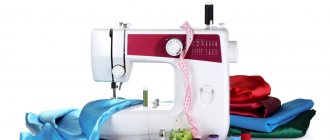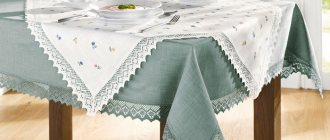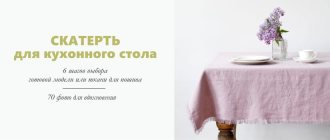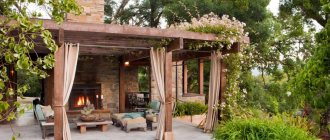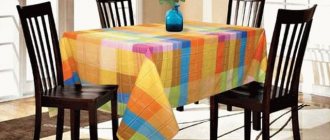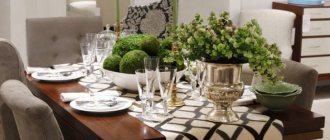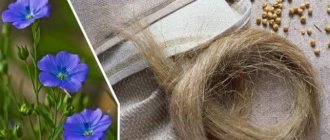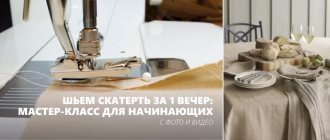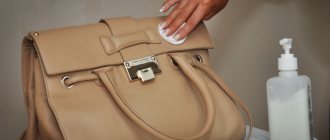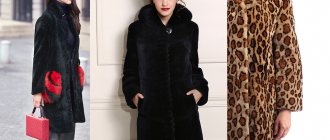A tablecloth is a useful and practical home accessory. It perfectly protects the countertop and hides defects that appear on it. In addition, it is a wonderful decorative element that creates a cozy and warm atmosphere. In order for a tablecloth to truly become a decoration of the table and the interior as a whole, you need to know the rules for selecting it.
A short guide to the article: Secrets of choosing “clothes” for the table
- Material
- Form
- Size
- Color
- Style
How to choose a tablecloth for a festive table
What mistakes should you avoid before purchasing?
The first thing we will voice in this article is possible mistakes. But then we’ll talk about what you should focus on when choosing this decorative element.
1. Be sure to take into account that the color of the tablecloth should be in harmony with something. If you buy one single tablecloth and its color is not duplicated anywhere else, then it will not look good. If you are already buying it, then be sure to take some matching chair cushions, towels or some other textile items.
2. Choose a tablecloth based solely on its shape. If you have a round table, then you need a round tablecloth. If it's square, it's square. Because a rectangle spread out on a square plane will not look as it should. And even more so on an oval surface. Dangling sharp corners are not that interesting, but rather just sloppy.
3. Do not buy a fabric tablecloth without impregnation for daily use, relying on the neatness of your household and special coasters for plates. If you count on this, then in 99 out of 100% you will be bitterly disappointed and face the prospect of daily laundry. What does the table look like while the tablecloth is splashing around in the washing machine? That's right, naked. Therefore, either take any water-repellent tablecloth for these purposes, for example, made of PVC, Teflon, or buy 2-3 fabric ones at once (and duplicate elements for them). Agree, this is all vanity, therefore, it is better to immediately take a tablecloth specifically designed for every day of use.
4. When choosing a tablecloth for the holidays, pay attention to the composition of the material. Synthetics will not work here, because on holidays the table is often decorated with candles and one slightest spark falling on the table can cause a fire. Don't be tempted by the fact that synthetics are easy to wash - safety comes first. If a small spark hits the linen fabric, it will also die out, leaving no trace on the tablecloth. And there can be no talk of an unexpected fire here.
That's basically all you need to remember. Now let's talk about what parameters to focus on at the time of selection.
Which material is better?
Whether it is a tablecloth for an oval table or a rectangular one, formal or everyday, it is always based on natural or synthetic fibers. Which ones to choose?
Natural materials - linen, cotton - stand out primarily for their natural origin. They are beautiful, impressive, but extremely impractical: they shrink when washed, stains are difficult to remove, and linen ones are also difficult to iron out (although they wrinkle very easily).
They will be an excellent addition to serving for a holiday; for every day you should choose something easier to care for.
The photo shows a crumpled linen tablecloth in the interior
Tablecloths made from a mixture of natural and synthetic fibers are perfect for everyday use. They look, unlike cheap plastic or PVC ones - expensive, but very easy to care for. Especially if the material is initially impregnated - Teflon blocks the surface from absorbing any contaminants, thereby increasing service life and simplifying cleaning.
Decide for what purpose you need a tablecloth
As we already wrote above, if you need an everyday tablecloth for the table, then it is better not to invent it and take only one with Teflon impregnation. These tablecloths come in many colors, so there shouldn’t be any problems. If you just can’t find exactly the tone you need, then you can do it simpler: buy a white and neutral Teflon tablecloth, and put a couple of runners of the desired color on top of it (these are long, narrow panels that are placed across the table).
In this case, your design will come out beautiful and you can sit down to dinner without worrying that someone will stain the tablecloth with sauce or something else.
If you are looking for a holiday tablecloth, then in addition to fire safety, keep the material in mind. Linen is an expensive option, but it is not always justified from a practical point of view, since it is quite difficult to smooth it out after washing. And, if we are talking about a huge tablecloth for a banquet table... Oh, ironing in this case will give you many “unforgettable” minutes (we were modest with the minutes, of course).
It is better to take ordinary, thick cotton fabric. It is easy to iron and dries faster.
There are also silk tablecloths for the holiday. It’s beautiful, expensive, unusual, but touching such a tablecloth with your bare hands is not very pleasant. And the plates will remain unstable on such a surface and there is a high probability of “fighting”. And this is not only a loss, but also an embarrassment for the guests...
So, if you are interested in our opinion, then, definitely, only cotton. Fortunately, the choice of colors is now simply huge. And, if you don’t find what you need, you can always buy a piece of fabric and sew the tablecloth yourself (or give it to a seamstress).
A few more recommendations for choosing a tablecloth
What should be the best tablecloth for daily use? Of course, practical. You should not choose an option for the kitchen made of fabric without water-repellent impregnation - you will face daily washing. Natural cotton and linen create comfort and amaze with a variety of colors. But they get dirty quickly, are difficult to wash, and take a long time to dry.
If you absolutely do not like oilcloths and “impregnations”, or you cannot find a suitable print in their assortment, buy an elegant canvas made of cotton or linen, and on top - a transparent coating of soft PVC with a thickness of 0.25 or 0.5 mm. Let it hang the same length as the textile (or a little longer), protecting it from all sides.
Or you can choose flexible glass (1 mm thick, or better yet 2 mm) and cut it exactly to the size of the tabletop. This way you will kill two birds with one stone: protect beautiful textiles from dirt and press them tightly to the table, preventing them from sliding or creasing.
We really hope that we have helped you understand the question of how to choose a tablecloth for the table. May your home always be beautiful, cozy, and festive.
Take the measurements from the table and build on them
How to choose the size of a tablecloth so that it looks perfect? You need to choose one so that the edges of its overhang are at least 20 centimeters. That is, if you have a square table one meter by one meter, then the tablecloth should be exactly 1.20 by 1.20. This is the most optimal length, but it can vary by plus or minus a couple of centimeters. Not more! Otherwise it will either be too long or too short.
But, this is the best size for everyday wear. If you are choosing a festive tablecloth, then you can, and should, take a longer overhang.
Floor-length tablecloths look great, and they also look very good with an overhang of 40-45 centimeters. Moreover, textiles for the holiday can be with flounces and lace. And the longer the free part, the more luxurious the table will look.
In general, exactly how much your tablecloth should hang depends on the table, or rather, on its height. Basically, it is standard, but there are also exceptional cases: let’s say your family is gigantic in size and you didn’t buy a table, but ordered it in individual sizes. And in this case, an overhang of 20 centimeters will look rather meager; here it is better to add those centimeters that you added to the standard height of the furniture.
Also, the moment of choosing fabric for the tablecloth deserves special attention. Here you must measure not only the overhang, but also the centimeters for hemming and shrinkage.
Regular cotton fabric will shrink about ten centimeters during the first wash, but linen fabric will shrink fifteen centimeters. So, add this: overhang 20 cm + hem 2-3 cm + shrinkage 10-15 cm, depending on the properties of the fabric.
What to consider when choosing?
Are you choosing a tablecloth for the first time? Please pay attention to important nuances:
- Tablecloth size. The table covering should not be smaller or flush - measure the table, add 30 cm to each parameter for the overhanging edges.
- Form. Like tables, tablecloths can be square, rectangular, round, or oval.
- Color. Will textiles complement the interior design or accentuate attention?
- Occasion. Festive ones differ from everyday ones primarily in decoration: they are more elegant and bright.
- Material. Fabric affects tactile sensations and appearance, depending on the style of the room. You should also consider the presence of allergy sufferers in the house.
Read more about choosing each option in the following sections.
Based on the overall style of your kitchen
Basically, tablecloths are now on sale that fit perfectly into “Provence” type interiors. That is, these are all kinds of checks, stripes, polka dots, ruffles... It is very beautiful and cozy, without a doubt. But, if your furniture is in the style of minimalism or hi-tech, then what kind of stripes with ruffles can we talk about?
Such a tablecloth will look extremely inappropriate and, instead of adding chic, it will simply be annoying.
What else would I like to say: our job was to advise and warn, but you still know better which tablecloth is best for your kitchen.
Choosing napkins for the festive table
The etiquette rules regarding serving are quite strict. Decorating a festive table is unthinkable without napkins intended for each participant in the feast.
Don't forget about table napkins
Napkins made from fabric are very popular. It is desirable that such accessories have the same color as the tablecloth. However, if candlesticks, vases or special dishes are additionally used, then you can choose an option that is in harmony with the color of these attributes.
The color of the napkins should be in harmony with the color of the tablecloth
Using napkins, you can successfully organize an event dedicated to a specific topic. You should ensure that the type of fabric used to make napkins is the same as that of the tablecloth.
Decorate napkins according to your holiday theme
With the help of napkins you can add variety to your table decoration. You have a wonderful opportunity to show your imagination, emphasizing your style and grace.
Napkins as a bright accent on the holiday table
Pay attention to the drying speed of the material
Of course, there is no equal to synthetics in this parameter. And, in principle, a synthetic tablecloth is a completely acceptable option for daily use.
Washing such a tablecloth is a pleasure. And stains don’t eat into it that way and it dries in a matter of hours.
But for festive tablecloths this parameter is absolutely unimportant. Let it dry for at least three days, holidays don’t happen every day.
Tablecloth shape
The main shapes of a tablecloth are: square, oblong (rectangular), oval and round. It is necessary to select a tablecloth that suits the shape of your table:
- square table - square tablecloth
- rectangular table - rectangular tablecloth
- round table - round tablecloth, but square is also acceptable
- oval table - oval tablecloth, but it is possible to use a rectangular tablecloth if there is no oval one.
If possible, it is better to give preference to a tablecloth that has the shape of a table. The exception is a square tablecloth and a round tabletop. For small round tables, a square tablecloth is often deliberately chosen, since when laid on the table, it drapes in an original way and “flows” interestingly down from the tabletop.
However, more often a square tablecloth for a round table is used in combination with a contrasting round tablecloth (a smaller square one on top of a larger round one). All this is done mainly for decorative purposes.
Table textiles - not just a tablecloth
Cloth napkins. For formal gatherings, cloth napkins are a must. Fabric napkins are often sold complete with a tablecloth. This is convenient: the designers of such sets have already thought out the combination of colors of the tablecloth and napkins, so you don’t have to look for successful combinations.
The napkins can be made from the same fabric and the same color as the tablecloth, but it is preferable for the napkins to be at least a little different. They can even be contrasting. In a good way, a napkin lying on the table should not merge with the tabletop so that it does not fall out of sight.
Runner or track. This is the name given to a strip of fabric that runs the entire length of the table (often with an overhang), but is quite narrow. This path is similar to our traditional towel.
The path is used in different ways, there are no strict rules. More often it is placed in the center of the table on the tablecloth - in this case, the runner should be different in color from the main tablecloth. Dishes with common dishes, as well as vases with flowers and fruits are placed on the path.
In this case, the paths serve the function of decorating the table and protecting the tablecloth. However, the table runner can be laid directly on the tabletop without a tablecloth. In general, this is not prohibited by etiquette. However, it is advisable to prepare and place “plate plates” or place mats on the table - these are napkins that are placed on the table in front of each person sitting. Dishes are placed on these individual napkins, cutlery is laid out, etc. Thus, the tabletop remains protected: shared dishes are placed on the table runner, and individual dishes are placed on the underplates.
Another option is several paths placed across the table - one path for two participants in the feast sitting opposite each other.
Naperon. This is a small additional tablecloth, usually rectangular in shape, which spreads over the main tablecloth. The cover is used to protect the main tablecloth and, of course, to cover the table more aesthetically.
Experiment with table textiles, because a beautiful table means comfort in the home and satisfied faces of guests. Happy feasts to you!
How to choose tablecloths in the interior?
There is no clear answer to the question of which tablecloth is better. Such a product should be chosen according to several aspects, without respect for which your purchase either will not fit into the interior or will cause too much trouble.
When choosing an “outfit” for your table, you need to take into account several criteria, thanks to which you can choose the ideal option:
- Shape and size of the product;
- The room in which the table is located;
- Room design;
- Purpose of the purchased product.
Tablecloth color
The color of the tablecloth in the kitchen-dining room or living-dining room should fit into the overall color scheme of the room. So, for example, if the wallpaper in the room is white and green, the curtains are light green, and the upholstered furniture is beige, then the tablecloth can be green, white, beige, or green-beige.
In a light or dark monochrome interior, a tablecloth can be a bright spot, a splash of color. You can support the color of the tablecloth with 1-2 details in the interior.
However, there are also neutral options - these include tablecloths in cream, light beige, light pearl, golden and other similar shades. Neutral tablecloths are suitable for setting tables in any interior, regardless of style and color.
As for the tablecloth for the festive table , the choice here is limitless, because such a tablecloth does not have to match other interior elements in color, since it is laid for one day.
For the most special occasions, it is recommended to give preference to a white tablecloth.
For the New Year's table, you can choose a tablecloth in shades of green (the color of the Christmas tree), red (the color of the most common Christmas tree decoration), and silver (the color of sparkling snow). In addition, the New Year's tablecloth can also have a themed print - a herringbone pattern, with images of snowmen, etc.
